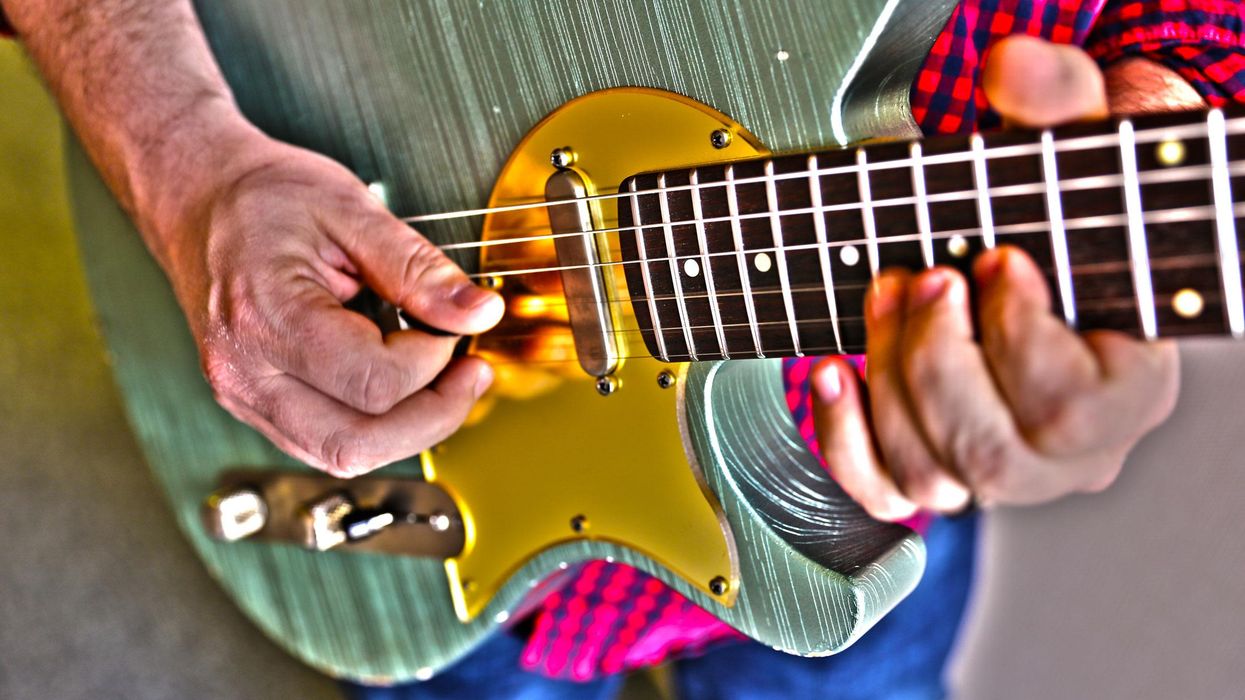Chops: Advanced
Theory: Advanced
Lesson Overview:
• Improve clichéd progressions by using borrowed chords.
• Understand how to target chord tones in your solo.
• Develop a better sense of composition with more interesting chord changes.
Click here to download a printable PDF of this lesson's notation.
How many times have you heard that same ol’ chord progression and thought, “This again?” It’s okay—that’s a common reaction. While typical progressions such as I-IV-V or bVI-bVII-Im are responsible for a lot of great music, it’s also natural to get sick of them sometimes. No matter how much you like pizza, every once in a while you might want something a bit more adventurous for dinner.
The good news is there are ways to keep our familiar chord structures in our music while dressing them up a little. (I see a late-night infomercial in my mind’s eye: “Lacking harmony in your harmony? Tired of the same old thing? Need to spice up your progressions? Fear not! We’ve got your new moves covered, for the low, low price of …”)
One way to do this is through modal interchange. Don’t stress. Modal interchange is just a fancy term for a simple concept: the practice of borrowing chords from a parallel mode and inserting them into your otherwise diatonic chord progression. Voilà! You have some tasty new moves.
With modal interchange, we’re not talking about randomly adding unrelated chords to a progression. There’s a bit of method to the madness, and once you learn a few rules, you can decide the degree of unexpectedness you’d like to introduce into your progression. This concept works when a progression is diatonic to any mode, but it’s most commonly used in major-key progressions. Several minor tonalities (such as natural minor and Phrygian) offer interesting chord options as well. By substituting borrowed chords for those we typically use in our cadences, we can delay the resolution or generate an element of surprise.
We must first understand how to build a diatonic progression. For those unfamiliar with the term, diatonic simply means “within the key.” So a diatonic progression contains only chords with notes that occur naturally within a key. Each key has seven diatonic chords (one built from each note in the scale). Here are the diatonic chords in the key of C major:
C–E–G = C (I)
D–F–A = Dm (IIm)
E–G–B = Em (IIIm)
F–A–C = F (IV)
G–B–D = G (V)
A–C–E = Am (VIm)
B–D–F = Bdim (VII°)
Let’s now take a look at the available diatonic chords in C natural minor (C–D–Eb–F–G–Ab–Bb), the primary key from which we’ll be borrowing.
C–Eb–G = Cm (Im)
D–F–Ab = Ddim (II°)
Eb–G–Bb = Eb (bIII)
F–Ab–C = Fm (IVm)
G–Bb–D = Gm (Vm)
Ab–C–Eb = Ab (bVI)
Bb–D–F = Bb (bVII)
Out of these seven minor diatonic chords, there are several that are commonly inserted into a major progression: IVm, IIm7b5 (the 7-chord version of II°), bVI, and bVII. Another commonly used chord is the bII, which is the second diatonic chord in C Phrygian mode. Perhaps the most commonly used chord in this list is the IVm, which can be found in many famous songs, and can easily provide a slightly surprising sound even when put into the simplest progression. In many instances, this chord can be found following the diatonic IV chord.
For my short solo in Ex. 1, I used a C major scale (aside from a few chromatics). When the Fm (IVm, our outside chord) came around, I hit the 5 and b3 of the chord on the first pass, and an Fm7 arpeggio on the second pass. When soloing over the outside chords, the parallel minor scale (in this case, C natural minor) will often work as the chords are usually borrowed from it. However, be careful when doing this because it won’t sound great if you suddenly switch to ripping in C minor! Instead, you want to target the scale notes that are centered around the tonality of whatever the borrowed chord is. That’s why chord tones are always a great choice. Extra points if you can weave those chord tones into a lick that moves smoothly to and from tones of the original scale without bouncing around too much.
Why is the placement of the IVm chord in this progression so strong? One reason is moving through this cadence offers an opportunity to craft a chromatic line using chord tones. Check it out: A (3 of F) to Ab (b3 of Fm) to G (5 of C). Incorporating this line into your melodies or soloing ideas can really illustrate the use of the borrowed chord in spicing up this otherwise too-familiar cadence.
Click here for Ex. 1
The bVII can often provide a nice surprise because it doesn’t sound harsh or weird, yet it’s slightly unexpected to our ears. It also can work well in a progression that holds our previously used borrowed chord. The bVII often has a dominant function, so in Ex. 2 I put it where the V chord could normally go.
We’re in the key of G. Notice how in this example, I target Eb, the b3 of Cm. On the first pass, I splice Eb between E (the 3 of C) and the little extended scalar lick in measure four, before finally resolving to the D (the 5 of G). Because both the outside chords used in this example come from the parallel minor, the scalar lick I play in measure four works over both the IVm and bVII (Cm and F) chords. As in the previous example, this is strong because it creates a smooth chromatic movement—in this case, E to Eb to D.
Click here for Ex. 2
Another super-useful borrowed chord, and one of my personal favorites, is the bII. Borrowed from Phrygian, it’s often used to delay the resolution back to the tonic, so you might see it make an appearance right ahead of the I chord. This half-step-above-the-root approach causes a lot of tension, so pull it out when you want listeners to hold their breath, so to speak. It sounds especially nice when spliced between the V and the I (as in Ex. 3), but can also be used for a dominant function when there is no V chord in the progression.
We’re in the key of G again. I took a very simple approach when soloing over this outside bII chord. Since the bII has such impact—thanks to the half-step shift to the root—sometimes emphasizing a chord tone is all it takes to make the line stand out. Here, I simply hit C (the 3) and then resolved the solo with a G minor blues lick. Because this chord comes from G Phrygian (G–Ab–Bb–C–D–Eb–F), a G minor phrase isn’t technically supposed to work. That said, playing a G minor line over the Ab chord actually provides some intriguing tension by setting up an A-against-Ab rub.
Click here for Ex. 3
In Ex. 4 we introduce the bVI-bVII-I cadence (commonly seen in diatonic minor progressions, like every Iron Maiden song ever) into a major key progression. These two chords, the bVI and bVII, work well in many major situations. I particularly like the effect when they follow the V chord, but they can be used in other ways—or even on their own, as an entire progression composed of a simple bVI-bVII-I. Some of the places you’ll find these chords may surprise you, such as in “Gangnam Style” (perhaps my favorite appearance of this move).
I decided to go for the gold on the soloing over these two outside chords. Since they appear at the very end of the progression, I’ve deemed it an appropriate enough place to do some light shredding. First, I resolve the bend in measure seven right into the outside chord by targeting the root (Eb). This adds the element of surprise, as our ears are expecting this bending lick to resolve in some other way. (Didn’t know this chord was coming, did you?) Then, I took the opportunity to climax out of the solo by playing a fast G minor scale run (centered around the Eb and F chords, of course) before resolving it back to G major.
Click here for Ex. 4
In our final example (Ex. 5), I’ve included several of the chords we’ve already seen, as well as a new one, IIm7b5. This chord is perfect for spicing up your subdominant function needs. In this example, you can really hear how well the bII works as a dominant chord, as well as a tool for delaying the resolution a bit.
This one was particularly fun to solo over. Because our first outside chord (F#min7b5) is a bit more intricate and colorful than what we’ve seen so far, outlining it by targeting chord tones can really make this tonality pop.
I cheated a bit by adding something to the mix—a m7b5 pentatonic sound. Instead of the typical pentatonic sound, I played a 1–b3–4–b5–b7 scale for the run in measure four. When it comes around to the IVm (Am), I once again target the 3 (C). To strengthen this move, I approached it by a step-wise ascending line in the original E major key, hitting the C right on the Am chord. I continue in the same fashion to reach the F on the bII, and complete the thought by eventually steering the line back to its resolution in E major.
Click here for Ex. 5
If you listen to the examples as backing tracks and then again with the solos over them, you may find that the melodic content helps to outline the changes and make them stand out. While the progressions certainly stand on their own, I’m a firm believer that they aren’t always the whole picture. Many times, a great arrangement, melody, or solo will really be the X-factor that illustrates the magic of these chord changes in action. Remember to think “big picture” when using this technique, and the borrowed chords will surely stand out in your music.




























